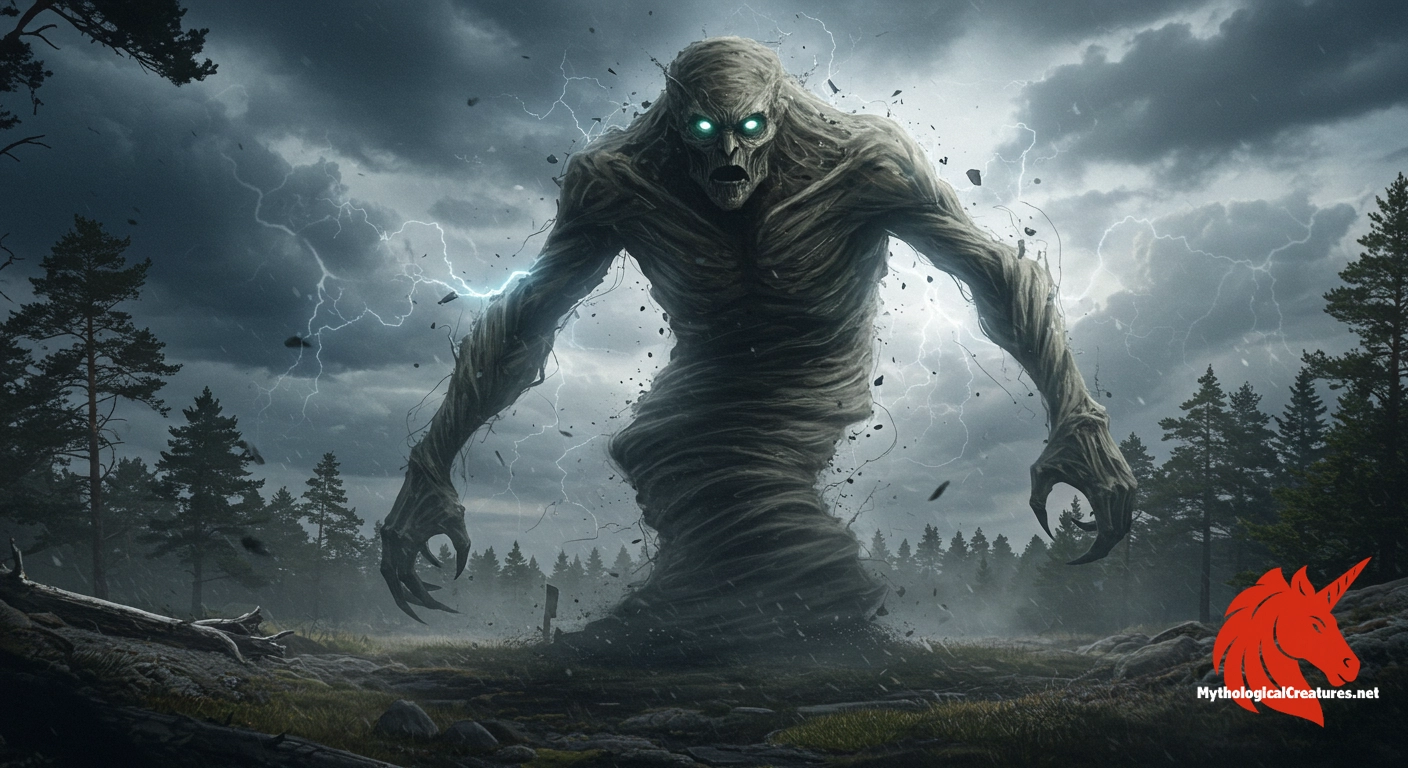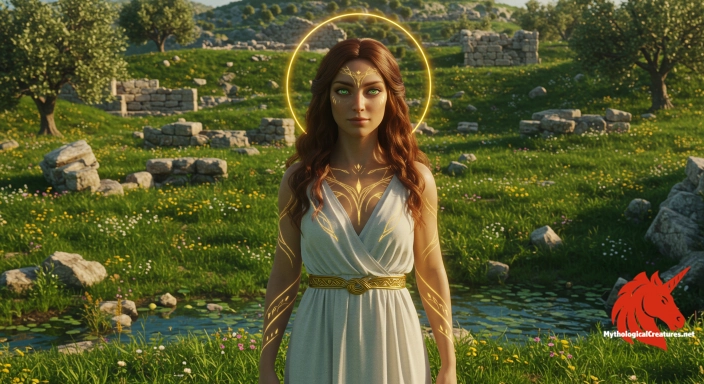Ebajalg: Ebajalg is a fearsome whirlwind demon from Estonian mythology.

Ebajalg
Ebajalg - Represents the chaotic and destructive power of nature, serving as a cautionary figure in folklore.
Origins & First Encounters
Ebajalg, whose name means 'whirlwind', emerges from the rich tapestry of Estonian myth as a force that embodies the raw power of nature. It is often portrayed as an unpredictable spirit straddling the line between a natural phenomenon and a supernatural entity. Rooted in ancient pagan beliefs, its origins reflect the deep reverence and fear that early Estonians held for the capricious forces of wind and storm. The first attestations of Ebajalg can be traced back to oral traditions that were later documented in folklore collections. This enigmatic presence has long been associated with sudden and destructive weather, offering an explanation for violent natural occurrences. Over time, its narrative has been layered with nuances that blend the elemental with the mystical, capturing the dual aspects of beauty and devastation. Ebajalg stands as a testament to the enduring human quest to understand and personify the overwhelming forces of nature. Its legend continues to inspire awe and caution, serving as a reminder of both nature's phenomenal power and its unpredictable temperament. In many respects, the myth of Ebajalg encapsulates the eternal struggle between human attempts at control and the inherent chaos of the natural world.
Source Texts & Tale Variants
Ancient manuscripts and fragments of oral tradition intermittently mention Ebajalg, though the details often come cloaked in rich symbolism. Multiple story variants have been handed down through generations, each adding its individual flavour to the whirlwind’s character. Some of the earliest accounts emerged from village storytellers in rural Estonia, where the spirit was evoked to explain sudden and violent storms. Later compilations by folklorists in the 19th and 20th centuries helped preserve these narratives, reshaping Ebajalg’s depiction as both sinister and mysteriously ambivalent. Variants of the tale sometimes present it as a vengeful force unleashed as punishment, while alternate renditions imbue it with a tragic quality born of ancient grievances. In certain narratives, Ebajalg is portrayed as a misunderstood guardian whose wrath is triggered by disturbances in the natural order. The diversity of accounts highlights the mutable nature of myth, with storytellers adapting its features to reflect changing societal concerns. Oral recitations and regional legends further enriched the myth, contributing layers of meaning that underscore the creature’s elemental origins. Each version, with its own distinct emphasis, forms part of a broader mosaic that has ensured the longevity and fascination of Ebajalg’s tale.
Form & Powers
Ebajalg is traditionally envisioned as a swirling vortex of air that takes on an almost tangible form, marked by an ever-changing, ethereal outline. It is said that during violent storms the whirlwind can assume shapes that are reminiscent of human features, hinting at an ephemeral, spectral visage. The dynamic energy of Ebajalg is often compared to the raw power of a tempest, a natural force that melds both captivating beauty and inherent danger. Witness accounts describe luminous, swirling currents interspersed with flashes that mimic lightning, lending it an otherworldly glow. Some depictions relate a sense of physicality to the spirit, as though it manifests visible patterns and textures within its spinning form. Its appearance is fluid and transient, with different narrations varying from descriptions of a colossal force capable of uprooting trees to a compact vortex that appears and vanishes in an instant. The perpetual motion within its form creates an intricate dance of light and shadow that has fascinated many an artist and poet. Every portrayal, while unique, echoes the uncontrollable energy of nature itself, evoking both marvel and dread. In this way, Ebajalg’s physical description remains as elusive and ever-shifting as the winds that inspire its legend.
Regional Faces
The myth of Ebajalg reveals fascinating regional variations across Estonia, with local lore adapting the creature’s attributes to match the peculiarities of diverse landscapes. In coastal communities, Ebajalg is frequently seen as an ominous harbinger of fierce storms, its presence signalling the approach of tempestuous weather. In more inland and forested areas, the whirlwind takes on a different aspect, often woven into local legends as a mischievous or vengeful spirit. Some rural narratives portray it as a solitary wanderer, whose sudden appearance brings both destruction and a form of natural renewal. Regional storytellers incorporate environmental features such as dense woodlands or open fields into their depictions, thereby refreshing the myth with unique cultural imprints. In northern parts of Estonia, local traditions sometimes blend Ebajalg with the identities of other elemental beings, highlighting the interconnected nature of regional folklore. These adaptations illustrate how the climate and geography of a given area can deeply influence the character and interpretation of mythological entities. The diversity of these stories reinforces the idea that nature’s forces are perceived differently depending on one’s surroundings. Through these regional variations, Ebajalg’s legend is continuously reshaped, retaining its elemental core while reflecting the unique spirit of each locale.
Cultural Parallels
Comparative analysis reveals that Ebajalg shares several common features with whirlwind and storm deities found in diverse mythological traditions. Its portrayal as an unpredictable and formidable force resonates with characters in Norse, Slavic, and Mediterranean mythologies, where the capricious nature of wind and tempest is often personified. Similar to the Greek Anemoi or the shifting spirits in Celtic lore, Ebajalg embodies the human fascination with the unpredictable moods of nature. In many cultures, swirling winds are attributed a life of their own, representing both the awe and the inherent peril of natural forces. The creature’s ambiguous role, oscillating between destruction and renewal, mirrors recurring motifs in global folklore that stress nature’s dual potential to create and to annihilate. Artistic and literary depictions from various traditions similarly capture this duality, echoing the dynamic energy seen in Ebajalg’s myth. Cross-cultural comparisons underscore the universality of human responses to natural disasters, emphasising both reverence and wariness. These shared characteristics help situate Ebajalg within a broader spectrum of elemental spirits that traverse geographic and cultural boundaries. Ultimately, such parallels reaffirm the timeless appeal of myth as a means to personify and understand the powerful forces operating within the natural world.
Legacy & Modern Evolution
Historically, Ebajalg was depicted primarily as a terrifying and malevolent force, a spirit whose violent manifestations served as a warning against the unpredictability of nature. With the passage of time, however, its portrayal has evolved from a simple agent of destruction to a more complex symbol encapsulating both chaos and renewal. During periods of national revitalisation, especially in the 19th century, the myth was reinterpreted as a reflection of Estonia’s cultural identity and its intimate relationship with the natural world. Modern artists, writers, and filmmakers have since adopted Ebajalg as a metaphor for the uncontrollable, often transformative energies of life and nature. Contemporary renditions tend to explore the creature’s inherent duality, highlighting themes of both devastation and creative regeneration. Digital media and modern literature have reimagined Ebajalg as a sophisticated symbol that encapsulates environmental and existential concerns. Its legacy now spans a broad spectrum of creative expressions, from visual arts to multimedia installations, where the whirlwind stands as a dynamic emblem of change. The continual reinvention of Ebajalg’s image underscores the enduring power of myth to adapt and inspire, even in the modern era. Today, the legend remains an evocative reminder of nature’s indomitable force and the perpetual cycle of destruction and rebirth that shapes our world.
Interesting Fact
Ebajalg underscores the belief in nature's wrath embodied by supernatural forces in Estonian folklore, serving both as a mythological figure and a metaphor for uncontrollable natural disasters.
Quick Creature Info
Origin:
Features:
Associations:
Our Mythic Legendary Rating:

Habitat:
Supernatural Powers:
Physical Attributes:
Abilities:
Behavior:
Lore:
References
Discover Another Mythical Legend You May Not Have Heard Of?
Uncover the mysteries of ancient folklore and expand your knowledge of legendary beings from cultures around the world.
Dare to Meet the Eunomia....
Curated by the Mythological Creatures Team (rev. May 2025)
